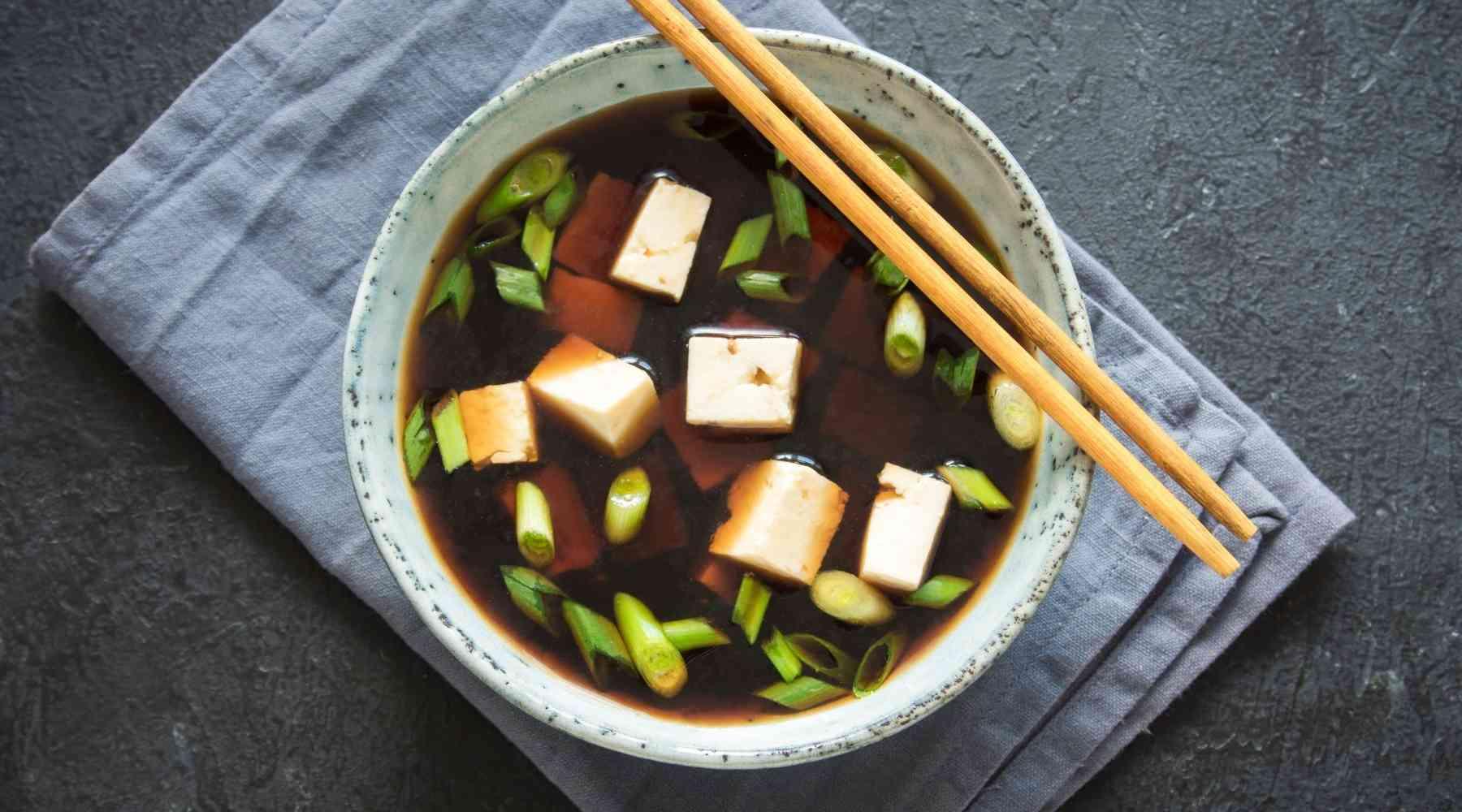 Buy Ingredients
Buy Ingredients Ingredients
Ingredients Directions
Directions Top Tips
Top Tips
Miso Soup

Miso is the first thing I think of when I hear the word “umami”. It’s a staple in Japanese cuisine, and most of the Japanese population consumes miso soup at least once a day. The first time I encountered Japanese miso soup was in a sushi restaurant. I ordered a big plate of sushi rolls and the waiter recommended I have miso soup on the side.
I was fairly new to Japanese cuisine at the time and, to be honest, didn’t like the sound of miso paste due to the “fermented” aspect (how times have changed!). Fortunately - thanks to a couple of pushy friends I was dining with - I tentatively tried the soup and boy did I fall in love!
The soup filled my mouth with a salty warm embrace, awakening my senses in between bites of pickled ginger and sushi slathered in spicy wasabi. I went home that evening and started researching how to make miso soup at home. It turned out to be super easy, and my miso soup recipe was born!
Introduction
I’ve since switched to a plant-based lifestyle and have never felt better. Fortunately, it was easy to create a plant-based miso soup recipe, so I’ve not had to miss out on this simple pleasure. Homemade miso soup is one of my go-to’s when it’s cold outside. It can be a meal, a snack, or a side, depending on how many ingredients you fill it with.
What is Miso Soup?
At its most basic, miso soup is miso paste mixed with dashi. Miso is a paste made from fermented soya beans. It has that wonderfully salty, rich savoury flavour that is at the heart of much Japanese cuisine. And it’s absolutely essential for Japanese miso soup, otherwise, why would it be called miso soup?! The other main ingredient, dashi, is a flavoursome stock typically made by soaking bonito flakes and dried kombu kelp.
Bonito flakes are dried flakes of skipjack tuna so we won’t be using those here. But fortunately, it’s easy to make plant-based dashi by substituting bonito flakes with dried mushrooms. Aside from these two essential ingredients, tofu and wakame are commonly added. However, you can add a whole range of ingredients to make your own miso soup recipe. That’s why I think homemade soup is a great recipe to have up your sleeve.
Read on to find out how to make miso soup the plant-based way!
Origin of Miso Soup
Whilst miso paste is typically associated with Japan, miso initially originated in ancient China. Around 1300 years ago, it was introduced to Japan by Buddhist monks and became the miso paste we know and love today. At first, the fermented soya bean paste was used to spread on other foods or eat on its own. It was even used to pay the salaries of the elites!
When miso paste arrived in Japan, the use of mortars meant a finer grind could be achieved, and thus the paste was more easily dissolvable in water. This was when Japanese miso soup was born!
During the Kamakura period, Samurai warriors adopted the “Ichiju-Sansai” style of meals, which consist of a soup, a staple such as rice or soba noodles, a main dish, and some pickles. This is how many Japanese meals are still arranged today, with homemade miso soup being one of the most common features.

Miso Soup
- Prep Time: 5 minutes
- Servings: 10 People
Here’s what you need:
Main Ingredients
- 1-litre water
- 2 large dried Kombu kelp strips
- 6-8 large dried shiitake mushrooms
- 4 tbsp miso paste
- Silken tofu (you can add as much as you like)
- 2 tbsp dried wakame (adjust to suit your taste)
- 2 scallions
- A dash of tamari sauce to taste.
Directions
- To make the plant-based dashi, put your shiitake and kombu in a large glass jar or plastic container, and pour in water. Seal it and put in the fridge to infuse for at least 5 hours.
- After 12 hours at most, remove the Kombu and shiitake mushrooms so they don’t get slimy. And always strain the liquid before using the dashi!
- Rehydrate the dried wakame. Place in a bowl and cover with freshly boiled water. Set it aside for 5 minutes and then drain.
- Heat your dashi in a medium pan over low heat.
- Add a ladle of hot dashi to a bowl then add in your miso paste. Whisk the mixture until smooth.
- Add your bowl of the miso-dashi mix back to the pan with the rest of the dashi. Add your drained wakame to the soup, along with the sliced scallions and diced tofu. Simmer over low heat for 1-2 minutes, to warm it all through.
- Ladle the miso soup into a bowl, add a dash of tamari sauce to taste, and any additional toppings.
Top Tips
As I’ve already mentioned, the structure of Japanese meals often follows the “Ichiju-Sansai” style, which means “one soup, three dishes”. This is a great way of ensuring a balanced meal, and it’s one of my favourite ways of eating.
Pair a bowl of homemade miso soup with a side of rice, some slices of grilled and marinated tofu, and an assortment of pickled vegetables. If you don’t want tofu as your “main dish”, try a selection of tempura vegetables.
Feel free to add more small side dishes such as spinach, cucumber or wakame salad, or some fruits. There are no hard and fast rules other than balance!
Variations
The recipe I outline above is only the most basic of miso soup recipes! Once you know how to make it, you can experiment with all kinds of different toppings and additions for your delicious homemade miso soup. Here are a few suggestions to get your creative juices flowing:
Try making this miso soup recipe with different kinds of miso paste. White miso is made from soybeans that have been fermented with a larger quantity of rice. It is white or light beige in colour and has a soft and sweet taste, making for a delicate miso soup.
Yellow miso is made from soybeans fermented with barley, and sometimes a little bit of rice. It has a mild and earthy flavour and is a versatile choice that’s perfect for soups, glazes, dressings, and marinades.
Red miso gets its rich red colour from having a higher quantity of soybeans and/or a longer fermentation time. It has a deep umami flavour that can overwhelm certain dishes, but it makes for heartier miso soup. Red miso soup is my favourite in winter!
Try adding additional vegetables to this basic miso soup recipe. I love adding some finely shredded cabbage, spinach, tomatoes, or sliced mushrooms. Bulk it up if you want to make a meal of it!
To Wrap It All Up...
I hope you’re now feeling ready to make your own homemade miso soup! It’s one of those simple meals or snacks that feels like pure nourishment. You can enjoy it at any time of year but there’s nothing like a bowl of steaming hot miso soup on a cold day. Lazy nights in front of the TV can’t taste much better!
It really is hard to get it wrong. I’ve heard people complain that some of the ingredients can be hard to find, and that’s why PlantX wants to make things simple for you. PlantX is a one-stop shop where you can pick up both your essentials and those more “gourmet” ingredients (like wakame) that you’d normally have to go to a specialty shop for!
Frequently Asked Questions
If you love this recipe…
Try one of our other awesome and light plant-based side dish recipes!
Share this recipe
 Did you make the recipe? We want to see!
Did you make the recipe? We want to see!
Tag @GoPlantX on Instagram.
Buy products in the recipe

Please choose options for all selected products:



